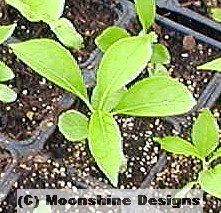To learn even more, read: Commercial Culture
Light: Partial to full sun. Best fruit in full sun.
Soil Moisture: Dry to moist.
Soil pH: Acid to neutral.
Hardy to zone 4 and some say zone 3.
Pollination: Some say that Bittersweet is self-pollinating. It can be, but it is rare. There are male and female plants. Both may bear fruit, but the female will bear heavily provided the male is present. If you are purchasing rooted vines, these are sold either as unsexed or sexed. Sexed plants are grown from cuttings, not seed. At minimum, you will need one female and one male. If you are purchasing seeds, there is no way to “sex” the plants until they reach bearing age which is usually in the second year. If you are purchasing seedlings or seed-grown transplants, plant at least 5 to assure pollination. There is no way for us to sex seedlings. 1 year rooted cuttings will not fruit the first year.
Seed culture:
The seeds have not been pre-stratified, so, for best results: Sow the seeds in a seed starting mix such as Jiffy Mix that is moist, but NOT SOAKING WET in a zip-lock bag and put in the fridge for at least 9 weeks. Remove from refrigerator and keep soil mix at 65-75 degrees and moist until sprouted. Keep out of the sun or they will cook! As soon as sprouts become apparent, plant into small pots using a good potting mix. Water as needed, but do not flood. Do not let them dry out either! Transplant when the first two true leaves are well developed. Use biodegradable pots (peat pots) or Jiffy-7s and plant the whole thing when transplanting. Transplant when the seedlings are about 4-6 inches tall.. It’s less stress to the plants and doesn’t disturb the root system if using peat pots or jiffy 7s but regular pots may also be used.. If the time for the plant to establish itself outside is short, mulch heavily for the first winter using straw or other loose material. Remove in the spring. Seed started plants will bear in the third or fourth year and occasionally in the second. You can further accelerate germination by pre-soaking in warm water for 24 hours before stratification. Anyone who has soaked dried beans before cooking is familiar with the process of softening up the shell. When the outer shell is softened it allows the contents to expand. Potassium Nitrate (Saltpeter) can help in softening up these outer shells. It is available in many drug stores. Soak the seeds in a solution of one teaspoon of the Saltpeter to one quart of warm water for 24 hours, but no more. Do not allow the seeds to dry out but sow them immediately using the remaining solution to water the soil or other growing medium. Have the bags or containers of growing medium or soil ready for planting as soon as the soaking period is complete.
NOTE: Bittersweet seedlings are prone to damp-off and root rot if over watered. Do not over crowd in flats and keep good air circulation around the seedlings. Allow media to dry out before watering!

Seedlings at 8 weeks from emergence.
Vine Culture:
Hedges: Space plants which are to form a hedge 12 to 18 inches apart. For general specimen use or as a ‘fence cover’, space 5-10 feet.
Grow along a fence or supply three support wires in a horizontal fashion 12”, 36”, and 60” apart. Set posts a maximum 10’ apart. #9 wire is recommended. Use of a turnbuckle at one end will enable you to tighten the wire if it sags. If grown on a trellis, be sure it is heavy duty and well anchored! A mature vine is heavy and combined with strong winds can easily collapse a trellis if not supported properly!
Mulching: All seedlings and transplants under three years should be mulched in the fall with grass clippings, straw or leaves.
Training Your Vines
If you have the seedlings or one year vines, a simple 6’ stake is all that’s needed the first year. For the two year and larger, a suitable fence, or arbor will be necessary. Train the vine straight up to the lowest wire, keeping the main trunk straight. We have pruned the top of larger vines and they will produce lateral branches that should be trained horizontal as they develop. Tying is not necessary as they will naturally twist themselves around just about everything (Keep that in mind if planted adjacent to other plants!) Just head the vine tip in the direction you want it to grow.
Prune as necessary to keep them within bounds. Best pruning time is November to March, but they can be pruned almost anytime. Flowers and berries are produced on the previous season’s growth, so do not prune to heavy! Blooming vines can be trained into a wreath shape for harvest after the first frost. Keep the wreath to 24” or less if not supported individually.
